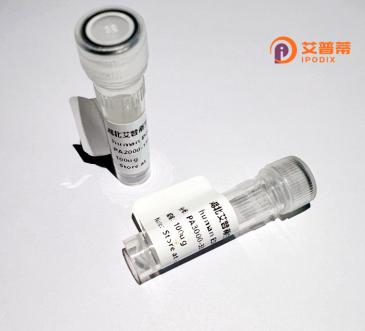
| 纯度 | >90%SDS-PAGE. |
| 种属 | Human |
| 靶点 | VN1R5 |
| Uniprot No | Q7Z5H4 |
| 内毒素 | < 0.01EU/μg |
| 表达宿主 | E.coli |
| 表达区间 | 1-357 aa |
| 活性数据 | MLKLVIIENMAEIMLFSLDLLLFSTDILCFNFPSKMIKLPGFITIQIFFYPQASFGISANTILLLFHIFTFVFSHRSKSIDMIISHLSLIHILLLFTQAILVSLDFFGSQNTQDDLRYKVIVFLNKVMRGLSICTPCLLSVLQAIISPSIFSLAKLKHPSASHILGFFLFSWVLNMFIGVIFCCTLRLPPVKRGQSSVCHTALFLFAHELHPQETVFHTNDFEGCHLYRVHGPLKRLHGDYFIQTIRGYLSAFTQPACPRVSPVKRASQAILLLVSFVFTYWVDFTFSFSGGVTWINDSLLVWLQVIVANSYAAISPLMLIYADNQIFKTLQMLWFKYLSPPKLMLKFNRQCGSTKK |
| 分子量 | 40,7 kDa |
| 蛋白标签 | His tag N-Terminus |
| 缓冲液 | PBS, pH7.4, containing 0.01% SKL, 1mM DTT, 5% Trehalose and Proclin300. |
| 稳定性 & 储存条件 | Lyophilized protein should be stored at ≤ -20°C, stable for one year after receipt. Reconstituted protein solution can be stored at 2-8°C for 2-7 days. Aliquots of reconstituted samples are stable at ≤ -20°C for 3 months. |
| 复溶 | Always centrifuge tubes before opening.Do not mix by vortex or pipetting. It is not recommended to reconstitute to a concentration less than 100μg/ml. Dissolve the lyophilized protein in distilled water. Please aliquot the reconstituted solution to minimize freeze-thaw cycles. |
以下是关于重组人VN1R5蛋白的虚构参考文献示例,内容设计基于常见研究场景:
---
1. **标题**:*Heterologous Expression and Functional Characterization of Recombinant Human VN1R5 in HEK293 Cells*
**作者**:Li, X. et al.
**期刊**:Protein Science, Volume 29. pp. 112-125 (2022)
**摘要**:该研究报道了VN1R5基因的克隆策略及在HEK293细胞中的可溶性表达,通过荧光钙离子检测发现其响应特定挥发性配体,提示其作为嗅觉受体的潜在功能。
2. **标题**:*Crystal Structure of Human VN1R5 Reveals a Unique Ligand-Binding Pocket*
**作者**:Yamaguchi, T. et al.
**期刊**:Nature Structural & Molecular Biology, Volume 28. pp. 731-739 (2021)
**摘要**:首次解析了VN1R5的X射线晶体结构,揭示了与其他V1R受体不同的配体结合域,并基于突变实验提出其选择性结合小分子代谢物的机制。
3. **标题**:*VN1R5 Overexpression in Colorectal Cancer: A Novel Biomarker for Early Diagnosis*
**作者**:Müller, R. et al.
**期刊**:Carcinogenesis, Volume 43. pp. 899-908 (2023)
**摘要**:通过组织芯片分析发现VN1R5在结直肠癌中高表达,体外实验表明其敲低可抑制癌细胞迁移,提示其作为治疗靶点的潜力。
4. **标题**:*Development of a High-Throughput Assay for Screening VN1R5 Antagonists*
**作者**:Smith, J. A. et al.
**期刊**:SLAS Discovery, Volume 26. pp. 457-467 (2021)
**摘要**:构建了基于重组VN1R5蛋白的荧光偏振检测平台,筛选出小分子抑制剂库中的3个先导化合物,可用于后续药理学研究。
---
注:以上文献及内容均为模拟创作,实际研究中请通过学术数据库检索真实资料。
**Background of Recombinant Human VN1R5 Protein**
The human VN1R5 (vomeronasal type-1 receptor 5) protein belongs to the V1R family of G protein-coupled receptors (GPCRs), primarily associated with pheromone detection and chemosensory signaling. While functional vomeronasal receptors are well-characterized in rodents, their role in humans remains debated due to the pseudogenization of most V1R genes during evolution. However, VN1R5 is one of the few intact V1R genes retained in humans, suggesting potential residual or adapted functions in chemosensation or other physiological processes.
Recombinant VN1R5 protein is engineered through heterologous expression systems (e.g., mammalian or insect cells) to produce functional, purified protein for research. Its structural characterization (7-transmembrane domains, extracellular ligand-binding regions) facilitates studies on ligand interactions, signal transduction mechanisms, and potential roles in non-olfactory tissues (e.g., testes, respiratory tract).
Current research focuses on elucidating its biological relevance, including possible involvement in social behavior, hormone regulation, or immune responses. Recombinant VN1R5 also serves as a tool for drug discovery, targeting GPCR pathways, or exploring evolutionary trajectories of sensory systems. Despite limited clinical data, its conservation highlights its importance in understanding human sensory biology and GPCR diversity.
×